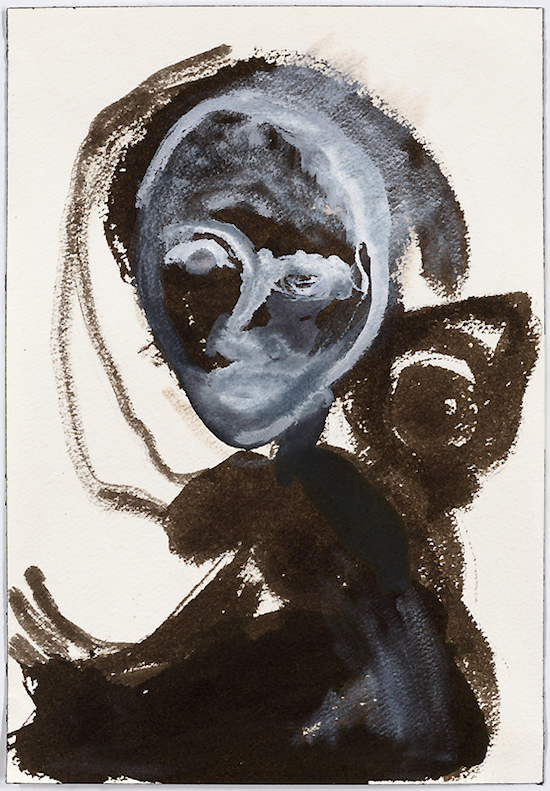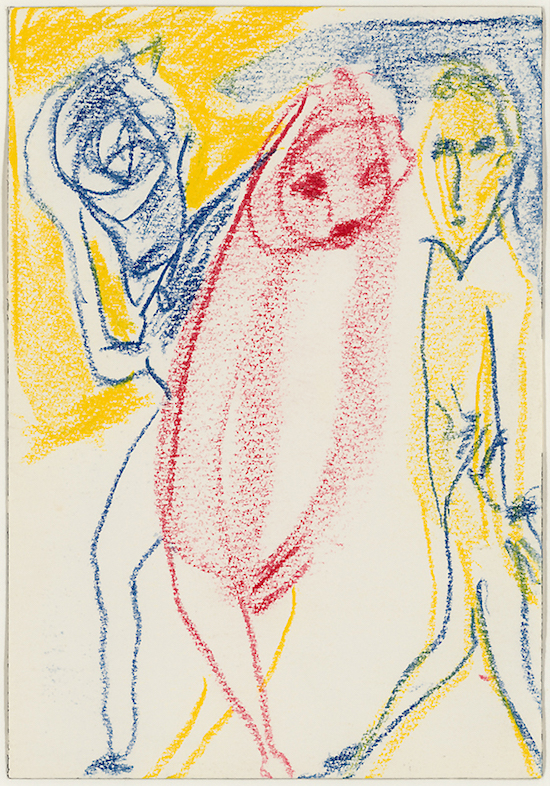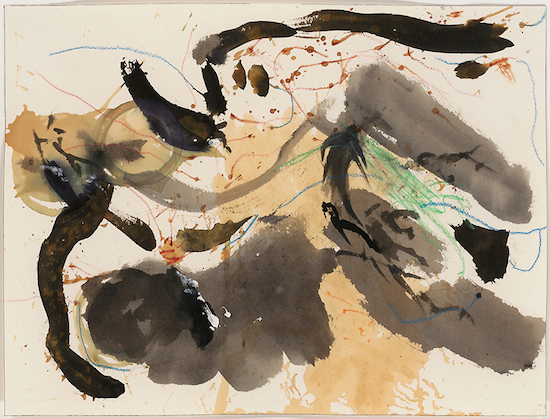Objectively critiquing the visual art works of a famous musician (or actor, or novelist, etc.) is no small order. How do you not immediately view the work through the lens of the music that you already know well and potentially love and/or loathe? When the artist in question is none other than Captain Beefheart, aka Don Van Vliet, already iconic for his wildly unpredictable approach to blues and rock n’ roll, that subjectivity gets mired in even more layers of preexisting opinion, and in my case, a deep and long-standing love and appreciation. But in the case of Van Vliet’s paintings and sculptures, an understanding of the man’s music actually helps understand what he was trying to do with visual art.
Captain Beefheart and his Magic Band, with records like Safe as Milk, Doc at the Radar Station, and his magnum opus Trout Mask Replica, sought a contemporary and avant-garde subversion of musical genres steeped in decades of Americana: rock n’ roll, country, and the blues. Van Vliet’s paintings, by turn, examine the landscapes of the United States – and in particular the deserts of California – finding in its visual cues something more sinister, unhinged, and wild.
When viewing the paintings currently on view at Michael Werner Gallery in New York, entitled Don Van Vliet: Works on Paper, you could point to similarities that Van Vliet’s paintings share with abstract expressionists like de Kooning or Franz Kline, or perhaps latter day neo-expressionist painters like Basquiat or David Salle. But at the same time, Van Vliet’s paintings really don’t look like any of those artists. The images in the paintings appear blotted and haphazard – almost disturbingly so. There is none of the sophistication of those aforementioned artists, but there is a kind of primal connection to the sort of pained imagery that haunts the closed mind’s eye.
Are the paintings actually good? Well, yes; they are quite good. But they are totally divorced from contemporary art, and can’t neatly fit into the history of what we know as outsider art or art brut either.
Van Vliet never received any institutional artistic training, and liked to joke that “half a day of kindergarten” was the extent of his education. But despite the perceived primacy of his paintings, Van Vliet was a locally famous artistic prodigy long before he was a musical icon. He began painting and sculpting at age three and gained local notoriety for his renderings of various animals. By age nine, Van Vliet won a children’s sculpting competition that would result in an apprenticeship with local tutor Agostinho Rodrigues who regarded the young Beefheart as truly gifted.
The future Captain Beefheart didn’t become enthralled with music until his parents moved from Los Angeles county to the Mojave Desert, where he would spend so many hours in his room painting, sculpting, and listening to music (Cecil Taylor, Ornette Coleman, Robert Johnson, etc..) that his parents reportedly served him dinner through his bedroom door. And even as he befriended Frank Zappa and went on to make several classic records of iconoclastic genius, a career in the visual arts was always where he saw himself ending up.
In the end, Van Vliet did seem to leverage his status as an outsider icon of strange music to develop a lucrative career in fine art, and it was his paintings and sculptures that eventually afforded him financial freedom. Such is the beauty of the art world that one can make strange and abstract work and still be celebrated and well-compensated. In a roundabout way, Beefheart’s cultivation of a mythic presence in the history of popular music may not have resulted in him selling many records, but it probably contributed to the fruitful and prosperous career he had in fine art from the mid-80s until his death in 2010.

The paintings on view at Michael Werner appear neatly framed and meticulously hung, belying the aggressively simplistic, albeit evocative, imagery contained within the work. Van Vliet paintings, even though they aesthetically share characteristics with the likes of de Kooning and Franz Kline, elicit an entirely different emotional response. De Kooning, Kline, Rothko, and Pollock’s abstract paintings all served as emotional springboards; near blank geometric forms that a viewer could stare at, get lost in, and project their own internal struggles and thought processes onto. Van Vliet’s paintings, by contrast, are defined by solitary figurative shapes (sometimes more than one) set against minimal palettes of abstract color and form. One can simply look at these paintings, identify its meaning, and move on. Interestingly, Van Vliet’s paintings work decoratively – albeit, in a creepy way.
All but one of the paintings and drawings in the show are untitled, and Van Vliet’s visual art works best when it gives you as little information about its subjects as possible. While a great deal of the works in the show are colourful, its Van Vliet’s monochromatic paintings that elicit the most poetic response. In an untitled work from 1987, two figures are positioned side-by-side. One figure, in a lighter shade of grey, resembles a face emerging from a cloud of smoke while facially gesturing towards the viewer, menacingly. The other, a dark shade of black, while highly abstracted, seems to form the silhouette of a man positioned for a prayer. There is an element of fear and unknown in this painting. Van Vliet seemed to be able to contort imagery into something more sub-consciously evocative.
The later works in the exhibitions, made from the late 1980s to Van Vliet’s death, ditch paint in favour of coloured pencils. They are even sparser and less pictorial than the paintings. Instead, they seem to tap into Van Vliet’s primal connection to language, and possibly, sound. They are also extremely hard to accurately critique. The charms of Beefheart’s music and art works have always been difficult to succinctly communicate through the written word. “As reviews over the years have proved, it’s always difficult to write anything that really says something about Don Van Vliet,” said Lester Bangs in his seminal 1980 Village Voice profile of Captain Beefheart. I couldn’t agree more. Van Vliet’s creative output works on such a sub-conscious level; there’s just enough familiarity in there to make the connection but the real magic of his genius just burrows into the deep recesses of your brain like a deeply altering but impossible to remember dream.

Van Vliet’s drawings are simultaneously irritatingly amateurish and undeniably haunting. To really appreciate them is to forget everything you know about art history and the conventions of composition and to give yourself over to pure, unfettered expression. Take for example, his drawing Untitled (1985): from a compositional standpoint it looks like a badly rendered drawing of a clown. But it’s something in that clown’s face, which is monochromatic in juxtaposition to the red and yellow body, and his expression that hints at a tragedy that is felt but not understood. It elicits in the viewer some vague recognition that life itself is painful but beautiful. Its message is universal, yet incomprehensible.
When viewing Don Van Vliet: Works on Paper at Michael Werner Gallery, one can’t help but wonder if their appreciation isn’t misguided, if they are buying into the novelty of viewing visual art works by one of the American avant-garde’s most seminal songwriters and cult figures. But I am here to tell you that you shouldn’t divorce yourself from what you know about Captain Beefheart’s music in order to fully appreciate his artwork. Instead, his music gives us a greater sense of what he achieved with his visual art works. Beefheart’s primary interest was always in finding the uncanny within the banal. He drew upon well-worn legacies of American roots and blues music and created something alien and beautiful. His paintings and drawings work similarly, as in this exhibition we see that Van Vliet’s starting point was in classic tropes of American art: Californian landscapes, portraits, abstractions.
And yet, they really have nothing in common with any of the predominant American painters of the time. They are primitive, but they certainly have nothing to do with the more sophisticated primitivist palette of Basquiat. They are creepy, but have none of the polish of David Salle. Don Van Vliet was painting in his own little world – just as he was recording music in his own little world years prior. In that sense, he’s operating more in the realm of outsider art and art brut than he was in the actual art world. He’s a very hard artist to pin down. And that’s what makes engaging with his work thrilling.
Don Van Vliet: Works on Paper is at Michael Werner, New York, until 9 September


